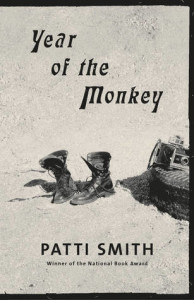
Part memoir and part meditation, part travelogue and part dream journal: this book takes us into Smith’s world during the unsettling year 2016. Smith’s wanderings during that Chinese zodiac year certainly embody a monkey’s traits of cleverness, curiosity, and mischievousness.
The year starts for Smith with a series of concerts at San Francisco’s Fillmore Theatre, followed by a surreal visit to Santa Cruz. From there she takes off on solitary wanderings to places like New York, Arizona, Kentucky, as well as to imagined and remembered places. She talks to strangers, meeting real and imagined people. She keeps vigil at the bedside of a beloved friend in a coma and visits another near the end of his life.
But more than her physical journeys, it’s what happens when she brings her particular mindset to grapple with the small irritations of life like the flood in her apartment, the larger problems in the country careering toward a showdown between democracy and what we then thought was populism in the November election, and most of all the death of friends and lovers, as well as the sense of her own time on earth running out as she approaches her 70th birthday.
It is art that holds her steady, whether studying the Ghent altarpiece or discussing Roberto Bolano’s work or a classic film. In one of my favorite parts she visits Fernando Pessoa’s house in Lisbon, and examines his personal library. He was a fascinating poet who wrote under his own name and 75 others, which he called heteronyms, creating full lives for each alternate personality.
In my classes on story structure, I’ve begun including a section on experimental structures. I tend to prefer more linear stories when I’m reading, but Jane Alison‘s book Meander, Spiral, Explode has helped me better appreciate other patterns and also to recognise them in stories that I’ve loved.
This memoir is definitely a meander, perhaps one of the hardest structures because it still has to hold together even as it wanders in a seemingly random fashion. Smith makes the challenge even greater by moving in and out of dreams and memory. As in Marilynne Robinson’s Housekeeping, the margins are fluid. Smith moves deftly between the humorous, banal, or wrenching moments that make up her year, finds signs and portents in unexpected places, and stumbles upon strange happenings.
I listened to the audiobook narrated by the author. Her distinctive voice—the audible one—carried me even deeper into the experience than I believe her authorly voice alone would have. I mostly listened to it as I was falling asleep. Thus, with the membrane between sleep and waking so permeable, the surreal turns and dream logic seemed fitting.
I’d like to read it again and study more closely how she made it all work.
What book have you read recently that you immediately wanted to reread?
